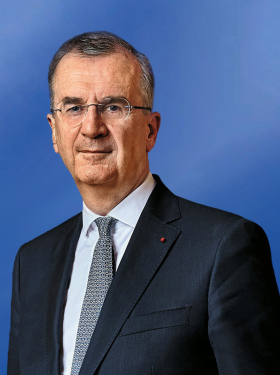- Home
- Governor's speeches
- Releasing the screw ? Monetary policy at...
Releasing the screw ? Monetary policy at a crossroad

François Villeroy de Galhau, Governor of the Banque de France
Published on the 16th of April 2024

Economic Club of New York, 16 April 2024
Speech by François Villeroy de Galhau, Governor of the Banque de France
It’s a great pleasure to be here at the Economic Club of New York. Henry James, the great American novelist and born New Yorker, was also a fine connoisseur of Europe. He once wrote: “It is a complex fate, being an American, and one of the responsibilities it entails is fighting against a superstitious valuation of Europe”. i 150 years later, one can almost reverse the quote. It is a complex fate being European today. And it takes responsibility to acknowledge our similarities and differences with the US, and escape the temptation of relying too much on our cross-Atlantic counterparts for guidance on economic decisions.
Monetary policy is not exempt from this temptation. There is often the perception that the ECB cannot or will not act unless the Fed does so. Let me be clear upfront: as Christine Lagarde said last Thursday “we are data-dependent, we are not Fed dependent”. ii We take our decisions according to our domestic mandate of 2% inflation and based on our best assessment of euro area data and of the outlook.
That said, we live in the same uncertain and – still more in these days – risky world; our shared Transatlantic discussions and trust are our common treasure; and we have seen parallel evolutions over the last two years, mainly driven by common inflation developments, in turn driven by global shocks. But there are also important differences, on the drivers of inflation – due more to demand in the US, and more to supply constraints in the euro area linked to our greater dependence on imported energy – and on the level of the neutral interest rate (r*) that can achieve price stability. Today we observe disinflation proceeding in both areas, albeit at different speeds. In a recent speech echoing the latest successful French movie, iii I tried to explain the “Anatomy of a fall” in inflation. Today I would like to expand on three dimensions that I believe are of common interest, although I don’t pretend to comment on US monetary policy.
I. Why have central banks succeeded so far with a soft landing?
First, why have central banks succeeded so far to achieve disinflation and a soft landing in the face of supply shocks, which is quite unprecedented?
Central banks are said to achieve a soft landing if they can bring inflation back down to target at a low cost for employment – a low sacrifice ratio in economic jargon. Of course, part of the observed disinflation was due to the reversal of the same supply factors that caused high inflation in the first place, such as energy prices. And the resilience of employment might be supported by specific labor market factors, including its significant improvement in Europe and France. But I want to focus on the role of monetary policy in driving disinflation. Let me emphasize one aspect that is at the center of modern monetary policy, namely well-anchored inflation expectations.
Central bank independence and the shift to direct inflation targeting – instead of steering monetary aggregates – are an important legacy of the victory over inflation in the 1980s. A credible commitment to return inflation to target ensures that the public sees high inflation as temporary. Ultimately, this leads to price- and wage-setting remaining “anchored” around our inflation targets, and avoids wage-price spirals. A central bank with a strong and credible reaction function significantly shortens inflationary episodes and reduces the cost on activity and employment.
This is precisely the mechanism that played out during the inflation surge of 2022. As soon as monetary tightening accelerated in mid-2022, the initial rise in inflation expectations reversed downward. This solid anchoring of expectations marks a decisive difference with the 1970s: the enhanced credibility of central banks, thanks to their independence and the success of inflation targeting, has been bolstered by their forceful reaction, thus obviating the need to raise real interest rates to levels as high as those seen in the past.
My host and co-panelist, John Williams, has identified three criteria for assessing well-anchored expectations. iv Reviewing these for the euro area, the first two criteria – a lack of sensitivity of long-run inflation expectations to macroeconomic news and levels consistent with the target – are clearly fulfilled: long-term inflation expectations have remained rather stable and not too far from the ECB’s 2% target. The third “uncertainty” or dispersion criterion requires that uncertainty about future inflation should increase less than linearly with the forecast horizon. It is more challenging to assess due to data limitations. However, I take comfort in the evidence from the ECB survey of professional forecasters (SPF), which paints a somewhat similar picture to the US. Namely, the increase in aggregate uncertainty around inflation expectations was more pronounced at short-term horizons – say 1 or 2 years, compared to the longer-term horizon of 4/5 years. And while the increase in aggregate uncertainty reflected both an increase in disagreement among forecasters and an increase in individual uncertainty, disagreement across forecasters has now largely receded since the peaks of last year.
That said, it is important to acknowledge two limitations: we do not yet fully understand how households and business form expectations nor how this maps into their actions. And the expectations channel should not lead to think that monetary policy works like a magical incantation: central bank credibility hinges on concrete actions and their impact on credit and demand.
And this impact is tangible. Various models developed by the ECB and the Banque de France quantify the contribution of monetary policy to the disinflation, estimating that inflation would have been around 1 to 2 percentage points higher in 2023 in the absence of policy rate hikes. The impact in 2024 and 2025 would be even larger, due to the lags of monetary policy transmission.
II. Will we succeed in the end? The last mile challenge
So what now? Shall we simply rest on our laurels and celebrate our success? Certainly not. Success is not ensured until the end, namely durable convergence around 2% inflation. Unexpected and exogenous shocks could arise along the road. And a number of observers and policy makers have expressed concerns that the last mile of disinflation might be more arduous. Disinflation now needs to extend to the “core”, and primarily to services: it will therefore be different, they claim, harder, and with less tailwind from the base effects of energy disinflation. In economic terms, the Phillips curve would not be linear and would be less favorable now, leading to a higher “sacrifice ratio”.
But as far as the euro area is concerned, there is no serious evidence to support this fear of the “last kilometer”. Admittedly, services inflation remains higher at 4%. But it has started to fall after peaking at 5.6% in July 2023; historically, its average has generally exceeded the headline target of 2%, but it is still compatible with it because of slower trend growth in goods prices (which are now at 1.1% inflation). Moreover, there are no signs of a wage-price spiral, which is important as wages are particularly relevant for services. On the contrary, average compensation per employee is slowing markedly.
True, services disinflation can be slower, but not more arduous; the last kilometer could differ in pace, but not in nature. v Moreover, accepting that this last kilometer could naturally take longer may also provide protection against the risk of undershooting the inflation target, rather than remaining excessively tight to accelerate the process. This is why the time has come, in the euro area, to ease monetary restriction: following our Governing Council meeting last week, we should, barring major shocks or surprises, decide on a first rate cut at our next meeting on 6 June [by the way, on the 80th anniversary of the D-Day]. I would then argue in favour of a policy of pragmatic and agile gradualism: there will have to be further cuts this year and next; their pace will be guided by the data, in a genuine meeting-by-meeting approach. We do not have the same business cycle as the United States, with activity that is much less buoyant: the gradual easing of our monetary policy is therefore more evident, even though it should not be complacent.
That said, we will monitor closely the geopolitical developments in the Middle-East, and their possible spill-overs on energy prices. If ever these consequences happened to be lasting and propagating – i.e. affecting underlying inflation –, we would have ample room after the first rate cut to adjust the pace and the destination if needed, in the incoming monetary path : indeed, we’ll anyway still be in restrictive territory for a while.
III. Where could we end? Is the neutral real rate (r*) helpful?
Last, where could we end? Here the economic profession gets divided about the use of a concept dear to John Williams, the neutral or equilibrium rate r*: the rate that balances supply and demand, and savings and investment as well. It is both an essential structural variable and a key cyclical marker: it is the dividing line between a restrictive and an accommodative monetary policy – if inflation is too high, interest rates have to go above r* to curb demand, and conversely. But the challenge is that r* is not observable and needs to be estimated: for this reason, some doubt whether the concept is even relevant. I am however a “r* believer”, and the ECB and the Banque de France have ventured some estimates, using a series of semi-structural models.
These estimates show that the pandemic marks a halt in the two-decade long downward drift in r* on the back of lower growth and population ageing. This might be good news for the economy in general, and monetary policy in particular: the risk of interest rates hitting the effective lower bound has slightly eased.
Our estimate suggests that in the euro area, the real neutral rate is now slightly positive, between 0% and 0.5%; and therefore the nominal neutral rate, adjusted for 2% inflation, could be between 2% and 2.5%. In the United States, it could be around one percentage point higher, taking into account the surplus of investment over savings, and stronger demographics and productivity gains. This 2% to 2.5% range is a reasonable estimate of the average of ECB policy rates over a future full monetary cycle. However, this is not necessarily the target for the current rate-cutting phase: it simply shows that we have significant leeway to lower our rates before exiting restrictive territory.
To sum it up, echoing Henry James famous novel, the time for a “turn of the screw” on euro area monetary conditions is over; now time is coming in Europe to start to gradually “release the screw” and lower the pressure. Thank you for your attention.
iJames, H., Letter written in 1872.
iiLagarde, C., ECB press conference, 11 April 2024.
iiiVilleroy de Galhau, F., “Anatomy of a fall in inflation: from a successful first phase to the conditions for a controlled landing “, speech, 28 March 2024.
ivWilliams, J., “Effective dialogue and well anchored inflation expectations: essential tools for navigating challenging times “, in Central Banking in the Americas: Lessons from two decades, BIS, November 2023.
vRapach, D., Is the last mile more arduous?, Federal Reserve of Atlanta, January 2024.
Updated on the 16th of April 2024